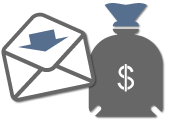 Email marketing has grown tremendously. In fact, here at Palmer we estimated that our email marketing campaigns have grown at least 30% to 40% over the past several years.
Email marketing has grown tremendously. In fact, here at Palmer we estimated that our email marketing campaigns have grown at least 30% to 40% over the past several years.
Email remains one of the most cost effective ways of reaching your potential new clients and introducing new products and services to existing clients.
If you’re a financial institution relying heavily on traditional outbound marketing practices, consider the effectiveness of integrating inbound marketing tactics as well. Especially e-mail marketing. According to Inc.com, e-mail marketing is “the preeminent way to draw traffic to your company’s website and increase sales revenue.”
Inbound marketing for your financial institution can include providing information about investment programs, asset management tools and retirement accounts, for example. Emails are a vastly underestimated means of acquiring new customers and retaining existing ones.
Providing financial services to other businesses? Great! “59% of B2B marketers say email is the most effective channel in generating revenue,” according to HubSpot.
Follow these basic guidelines that have proved to provide deeper relationships and expand market share for other financial institutions.
- Expand your database – The first step in any email marketing strategy is to collect as many email addresses as possible. (DO NOT buy e-mail lists.) Many of your customers may never have had a reason or opportunity to divulge their e-mail address to you, so your institution may need to take active steps to acquire them. Set up a table at your bank or credit union’s entrance to greet people and ask for their email information. If this is less effective than expected, you can offer a raffle with prizes like a free lunch for their office or a new iPad; just ask them to enter their email to enter. Create a reflective offer in the form of a landing page on your website to gather email addresses online.
- Intriguing subject lines – The first challenge of an email campaign is to get past the spam blocker, the one provided by the recipient’s email service and the recipient himself. Avoid words like “easy to use,” “ground breaking” and “reminder” which can trigger a spam block and lowers open rates. Subject lines should be simple, product specific and to the point. If you can include the word “exclusive,” do it. According to HubSpot, “the word ‘exclusive’ in email promotional campaigns increases unique open rates by 14%.”
- Personalize – If you have access to personal information, you should do your best to customize the email. Including their name in the subject line, as the greeting improves open rates and draws the attention of the recipient to the body of the email. If you narrowly segment your recipients, your software may be able to add other personalized touches like background colors and flourishes that may match their tastes like those of their personalized checks.
- Choose your audience – If you are marketing a new type of financial product like a retirement account, you should direct your emails to households with substantial and stable incomes. If you are encouraging customers to consider general products like a savings account, you can send these emails out in a more general blast. Tailoring your email campaign will limit the likelihood that you will get unsubscribes and optimize the conversion rates.
- Time your messages carefully – Studies have shown that a single message is rarely enough to inspire action. Most customers won’t respond until at least three messages have been received within a week. This may seem excessive, but research shows that a series of emails over a short period of time is highly effective at sparking action. Holidays, birthdays and the start of school are also important points on the calendar when customers are more likely to consider financial programs for their future.
- Ask for referrals – Asking your customers to recommend your institution to friends and business partners can be extremely effective. Many customers won’t refer someone unless it is in their best interest, so you may wish to include an incentive like free movie tickets or a bounced check fee waiver.






